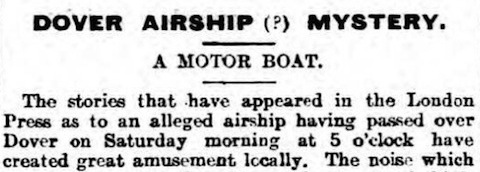
The Daily Express and the Standard both carry articles today trying to make sense of the phantom airship sightings, each framed very differently. The article in the Express begins by asking (p. 5; above):
Is a German airship making flights by night over England? That is a question which is being asked by many people in view of the repeated reports of a mysterious night aircraft from various parts of the country.
And it closes by noting:
The Hansa can travel at the rate of fifty miles an hour, and has a range of 1,000 miles. It is about 500 miles in a straight line from Friedrichshafen, on Lake Constance, where the Zeppelins are kept as a rule, but there are airship garages further north in Germany, and the German coast is less than 500 miles from Manchester.
By contrast, the Standard opens with a less leading question (p. 7):
What is the mysterious air craft that has been seen half a dozen times at as many different points, hovering by night over English towns, during the past three weeks? Whence does it come, and where does it hide itself during the day?
It also is rather dismissive of the idea that the airships are German:
The somewhat alarming theory that it is a foreign airship is generally discounted. For a craft of this description to have made a voyage lasting three weeks without landing and being observed is held to be a sheer impossibility, while it is considered almost equally impossible that half a dozen separate visits, including all the places at which the the mysterious vessel has been reported, should have been made from abroad.
Another difference is that in the Standard‘s article, those who have ‘generally discounted’ the foreign airship theory are certain ‘military and naval authorities’, whereas the Express seems to be talking more about public opinion. Nevertheless, the Standard does admit that the mystery is ‘greatly exercising the minds’ of those authorities, and that ‘In official and aeronautical quarters nothing is known — or at all events nothing is admitted — of the identity of the elusive airship’. It does offer an alternative to the German theory:
The suggestion is made that it belongs to an unknown inventor who has secretly built a new type of craft and is adopting this unusual method of stimulating interest in his invention as a preliminary to offering it to the War Office. Another theory is that it is not one airship, but two or more, which would account for its being seen at places as far apart as Liverpool and Aberystwyth within the same hour on Saturday evening last. As the crow flies it is some eighty miles between these two places, and it is in the highest degree improbable that an airship is in existence in this country capable of travelling this distance in an hour.
The suggestion that the airship is the invention of a local inventor was made (implicitly, at least) last week by the Manchester Guardian, but has not attracted much support until now.
Both newspapers have a similar list of sightings to that published in the Express yesterday — though the Standard adds a previously unrecorded one at Chatham on 4 January, the same date as the Dover incident. Unfortunately it doesn’t give any other details. The Express makes up for this with a dramatic report from an outer suburb of Manchester (p. 5):
A leading resident at Stretford, Manchester, states that he saw an aircraft, which at first looked ‘like a huge ball,’ passing overhead in a southerly direction about nine o’clock on Monday night [27 January 1913]. He estimated its height at 700 feet, and saw that it carried a light, which at first seemed yellowish, but afterwards light red.
It seemed to be travelling at the rate of about forty miles an hour, and when over Eccles turned westward in the direction of Liverpool. It was, in the opinion of the onlooker, an aircraft of ‘huge’ size. No sound was heard, but that is attributed to the wind.
And now for something completely different. The Manchester Guardian reports that a mystery aircraft has been seen in Romania (p. 9):
It is reported from Jassy, near the Russian frontier, that at eight o’clock last evening [29 February 1913] an aeroplane with powerful searchlight was observed over the town coming from the direction of Russia. It manœuvred over the town for ten minutes, afterwards making towards the barracks. Troops were ordered out, and signals were made to the aviator to come down. The command was not obeyed, and two guns were fired at the machine. The aviator immediately put out his lights and disappeared. The affair has caused a great sensation.
Maybe it’s a local inventor trying to get the attention of the Romanian War Office?
![]() This work is licensed under a Creative Commons Attribution-NonCommercial-NoDerivatives 4.0 International License.
Permissions beyond the scope of this license may be available at http://airminded.org/copyright/.
This work is licensed under a Creative Commons Attribution-NonCommercial-NoDerivatives 4.0 International License.
Permissions beyond the scope of this license may be available at http://airminded.org/copyright/.




Pingback: Monday, 10 February 1913